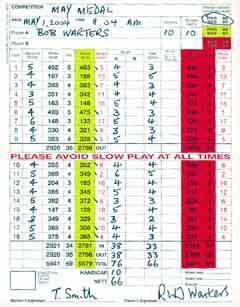The golf scorecard is a vital piece of equipment. Not only is it an official record of your score for competitions and handicap application but it also identifies various local rules to consider.
It needs to be handled with care and cherished to accurately record your performance and submitted, signed by yourself and the marker, to the committee immediately on the completion of every competitive round.
Here are dozen things you should know…
Competition
Always identify the competition for which the Scorecard is being used. Sounds obvious but without it the committee, which has jurisdiction over the competition, cannot accept the scorecard.
Date and tee time
It’s always advisable to include the date and tee time on any scorecard used in competition and for handicapping purposes – though not compulsory unless stated by the committee.
Names and handicaps
In singles competition always write your name clearly in the appropriate space on the card (Player A) together with your up-to-date handicap, which can normally be found on a regularly updated master list on the locker room or clubhouse noticeboard. It’s your responsibility to identify your handicap accurately.
In strokeplay you must ensure your handicap is recorded before you submit the scorecard. If no handicap is recorded before it is returned (Rule 6-6b) or if the recorded handicap is higher than that to which you are entitled and this effects the number of strokes received, you are disqualified, otherwise the score stands.
Exchange cards
Though golf is recognised is one of the fairest sports with the conduct of its competitors usually unimpeachable, it is compulsory to exchange cards with your playing companions before your round starts. Space is provided, usually in a column on the left hand side, for you to record your own gross score for each hole (on your playing companion’s card) and to match it with your official score at the end of the round.
Stroke holes/index
It is the player’s responsibility to know the holes at which handicap strokes are to be given or received in matchplay.
These are usually identified on the card in a different colour to the par for each hole.
It is not the player’s responsibility to accurately identify the strokes received in the space provided. The space is provided merely as a guide. The committee will work out the appropriate number of strokes received based on your current handicap.
In singles strokeplay medal this is normally apportioned with full handicap, though in the singles stableford points system, strokes received can be full, three-quarters or seven-eighths of the handicap, subject to the committee’s rules for that competition.
It is advisable to identify the holes in the Stroke Index column where strokes are received.
Which tee
In the column indicating which tee is being used it is recommended you circle the appropriate coloured box.
Gross score for singles
In singles strokeplay medal competition, it is compulsory that your gross score for each hole is recorded (ideally after each hole has been completed) correctly. If you return a score for any hole lower than actually taken, you are disqualified. If you return a score for any hole higher than actually taken, the score as returned stands.
The columns for net score and W (Won), L (Lost), H (Halved) and Points, are merely for guidance and personal record.
Bogey and par competitions
The marker of the card is responsible for marking only the gross number of strokes for each hole where the competitor makes a net score equal to or less than the fixed score (Rule 32-1a)
Total, in and out
Though there are spaces provided for your score for the ‘front’ nine holes (In), back nine (Out) and Total, it is not your responsibility to ensure the scores add up correctly.
Your performance will only be judged on your gross score for each hole – not your skill or otherwise at adding up. That is the responsibility of the committee, which also applies the handicap recorded on the scorecard (Rule 33-5).
Signing your card
Having exchanged cards back with your playing companions, check carefully that your score on your official card matches that which you have written in the ‘Marker’ column. Any disputes must be clarified before the cards are signed. Each card requires two signatures – your playing partner’s and your own.
Cards submitted and not signed will be disqualified.
Fourball competition
Recorded scores on the card differs slightly in fourball competition. Player A and B must be clearly identified with their names and handicaps in the appropriate spaces.
Also the player whose gross score is to count should be clearly identified in the appropriate column (with their gross score). A pair are disqualified when the recorded score of the partner whose score is to count is lower than actually taken. If the recorded score of the partner whose score is to count is higher than actually taken, it must stand as returned.(Rule 6-6d).
Foursomes/Greensome competition
Both players and their current handicaps must be identified in the appropriate spaces Player A and B.
As the competition demands the gross score for each hole after alternate shots (in greensomes the favoured drive is selected, with the player whose drive is not selected taking the next shot before alternate play), scores need only be record in column A.
Strokes are awarded based on a proportion of the combined handicaps (three-sixteenths for foursomes).
Have I missed anything? Tell us on the forum your experiences with a scorecard or unsual local rules you’ve discovered on the back.



